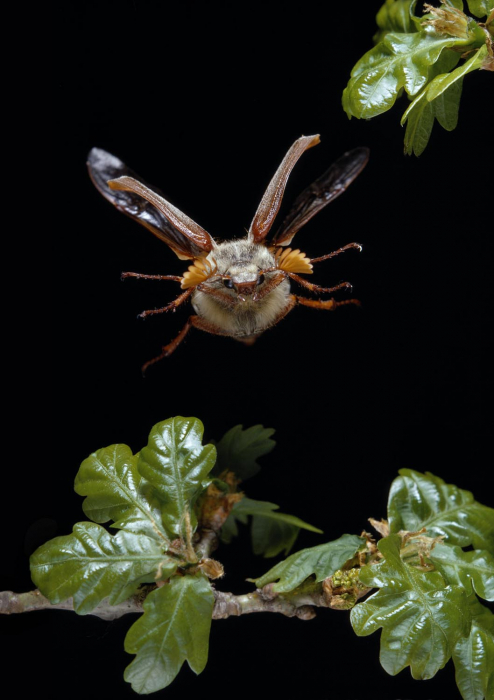Crunchy crumbs from the spring sun are easily given in hand and are in no hurry to fly away. Their funny “faces” aroused the delight of children and the desire to bring new friends home, where we began to find out what the May beetle eats, and how we can feed this “gourmet” at home.
Material Content:
Description and features of the insect
We came across an average instance of about 3 cm in length. Fan-shaped antennae and large bulging eyes gave the beetle a touching expression. Without a magnifying glass, numerous white hairs were visible on the head, chest, and hard red-brown elytra. The mandible and mandible with olfactory palps were examined in the picture in the encyclopedia, because it was not possible to fix the beetle for a detailed study. The insect was friendly, did not hide and did not bite, moved nimbly and purposefully. With the help of three pairs of legs with strong curved claws, our guest climbed on his bare hand as easily as on clothes.

In the process of searching for information, we learned a very interesting fact: May Khrushchev turned out to be a “malicious violator” of the laws of aerodynamics. From the point of view of scientists, thin narrow wings cannot lift the weight of his body: their design is unsuccessful, and the muscles are not sufficiently developed. Those who disagree with criticism carelessly fly, developing a speed of up to 3 km / h. A flying beetle gains air in hidden cavities and becomes three times lighter, turning into something between a blimp and a helicopter.
What feeds the May beetle and its larva in nature

First of all, the children and I found out which food the insect prefers in the natural environment.
The first summer, the furrow - the larva of the May beetle - feeds on thin roots of herbaceous plants. The next season, she chooses coarser food, gnawing young shoots of the underground part of trees and shrubs. After another year, her jaws cope with absolutely all the “goodies” underground. If the larva of the Khrushchev is lucky to “settle” in the garden or field, it will bite any root vegetables: potatoes, carrots, beets and dahlia bulbs. A malicious pest often spoils the crop on our site.
It is interesting! The importation of Khrushchev into North America is strictly prohibited by law. Here the May bug has no natural enemies. A gluttonous insect can cause an environmental disaster.
The adult May beetle eats solid plant foods, in large quantities destroys young herbs, flowers and ovaries of all plants in the vicinity. During the years of mass flight on the trees "captured" by the khrushch, you can see completely merged branches. Coniferous and deciduous crops, but especially fruit ones, suffer from pest attacks.
The menu is varied:
- maple,
- oak,
- Rowan,
- poplar,
- Birch,
- Apple tree,
- cherry,
- plum,
- gooseberry,
- currant.
Rare exceptions:
- mustard,
- lupine,
- elder,
- all kinds of cruciferous.
Khrushchev diet at home

Familiar fishermen told me about what the furrow feeds at home. They hold larvae in buckets of earth and use as bait for large fish. Insects are picky, eat any solid plant food: pieces of root vegetables, chopped greens.
The children were kept for two days. Twigs of birch, linden and currant with soft leaves were put in a plastic bottle with ventilation holes. The guest ate only freshly picked greens.
Good to know! "Gourmet" will be pleased if the leaves are moist and soft, not yet fully bloomed.
On the third day, the insect was clearly weakened: the lack of movement and the sun affected it. I had to let go of the horsetail.












